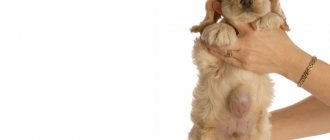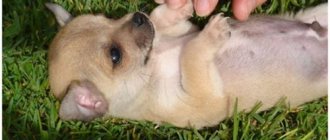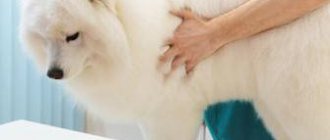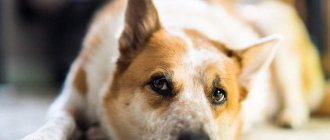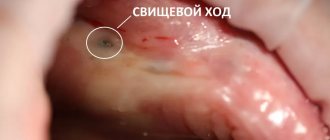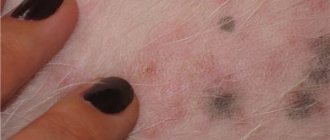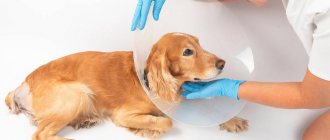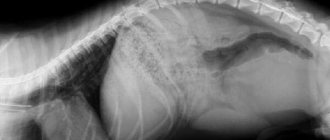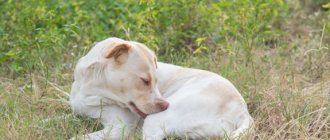Veronica Igorevna Sharipova
veterinarian Petstory
A hernia in a dog in the general sense is a protrusion of an organ or part of it under the skin between muscles, internal organs or bone structures through openings in anatomical formations. In other words, this is a local violation of the integrity of the body, manifested in a displacement of the normal anatomical location of organs relative to each other.
- Hernia removal
Most often, hernias occur in dogs; there is no gender predisposition. There are breed characteristics: for example, dachshunds suffer from intervertebral hernias more often than other dogs.
Why does an umbilical hernia appear in a puppy?
A hernia is the prolapse of part of an organ through the umbilical opening. In many animals it appears as a congenital defect on the navel. In the mother's womb, the puppy receives nutrients through the umbilical cord; during the birth process, the umbilical ring contracts and closes within 24 hours after birth.
Puppies in which compression does not occur due to low tone of the abdominal wall or irregular shape of the abdominal ring subsequently suffer a hernia.
An umbilical hernia may not always be a congenital defect.
In adult dogs it can occur for a number of reasons.
Causes of umbilical cord in a puppy or adult dog:
- frequent constipation;
- severe bloating;
- prolonged vomiting;
- peritoneal trauma;
- difficult pregnancy;
- difficult birth.
Umbilical hernia in a dog
Briefly about the main thing
- Hernias can be congenital - due to improper development of the fetus, or more often hereditary, and acquired - after injury or surgery.
- There are umbilical, inguinal, perineal, diaphragmatic, intervertebral and hiatal hernias, which mainly differ from each other in their location.
- Most often, the only effective treatment is surgery.
- Hernias are diagnosed not only visually, but using special research methods - radiography, ultrasound, endoscopy, etc.
- After surgery, it is important to limit the dog’s movements and provide a special diet.
Types of hernia
Umbilical hernia is divided into several types:
- A false hernia looks like a soft ball. If you press it in, it will go in easily, and then the space will fill with fat. A false one with a diameter of more than 2 centimeters does not grow, does not change color and does not cause pain to the pet. The veterinarian may not insist on removing the false one.
- The true one can reach the size of a chicken egg. It is much more dangerous; parts of internal organs, such as an intestinal loop or uterus, fall out through the ring.
Removal of a hernia in a dog
is divided into two types according to the method of treatment:
- The repositionable one yields to finger pressure and goes inside easily.
- A pinched one is often fatal and causes a lot of pain to the pet. The contents of the pinched organ cannot be set without surgery; the ring has already narrowed and stopped the blood flow to the area of the prolapsed organ.
Features of the location of the hernia and its treatment
Bulges are also classified according to their location. Depending on the location, the pathology takes on different course patterns and side symptoms. To detect a hernia, ultrasound or x-rays are sometimes used if there are signs of muscle ring formation, but no swelling is visible.
Hernia on the abdomen (Umbilical)
The most common manifestation, especially in newborns. Appears in the area of the umbilical canal and abdomen, part of the intestine falls into the cavity, which is why the hernia becomes rounded and becomes like a ball. The size of the neoplasm rarely exceeds 2-5 cm in diameter.
In adult animals, pathology occurs due to frequent constipation, increased gas formation, and bloating. When the disease is advanced, the dog’s activity decreases and appetite disappears. It is treated not only surgically, but also conservatively: bandages, bandages, massages.
Inguinal
More often observed in females. The uterus, bladder, and intestinal loops enter the hernial orifice. In addition to the appearance of a ball in the groin, there is an increase in basal body temperature, nausea, vomiting, depressed general condition, and increased heart rate and breathing.
Males are characterized by pain impulses when palpating the testes, and for females - when palpating the loop or lower abdomen. If the bladder is pinched, anuria and involuntary urination occur.
Inguinal in small breeds
In small dogs, an inguinal hernia appears during pregnancy due to weak abdominal muscles. In this case, the uterus with the fetus descends into the ring, so the neoplasm increases as pregnancy progresses and the fertilized cell grows. This pathology is dangerous not only for the mother, but also for the unborn puppies.
Perineal
Rupture of the pelvic muscles. Those at risk are unneutered males, older dogs and breeds with short tails. Reason: constipation, prostatitis, inflammatory processes. The colon or rectum, prostate gland, and bladder prolapse into the hernial cavity.
A large ball-shaped lump appears around the anus or in the perineal area. The tumor is soft, causes severe pain when palpated, and makes defecation and urination difficult. If a rupture occurs, death is inevitable. For pregnant bitches, the appearance of a perineal hernia is equivalent to an abortion.
Intervertebral
A rare form, typical for older dogs that have been involved in transportation or sports all their lives. A hernia is characterized by protrusion of the vertebral cartilage into the formed fibrous ring of the spinal canal. The problem disrupts the functioning of several intervertebral discs.
A hernia is expressed by acute back pain, paralysis, lameness, and failure of the hind or forelimbs. The animal stops running, playing, and doesn’t want to go for walks. For an accurate diagnosis, an x-ray is needed.
Diaphragmatic
From the name it is clear that such a hernia occurs due to a violation of the integrity of the diaphragm. Because of this, organs from the abdominal cavity rise into the intercostal or thoracic space. This pathology is accompanied by pulmonary edema and disturbances in the functioning of the heart. Characteristic symptoms appear:
- Blue discoloration of mucous membranes;
- Oxygen starvation;
- Anemia;
- Arrhythmia;
- Nausea and vomiting;
- Bulging in the chest area.
Diagnostics
Only an experienced veterinarian can diagnose a dog with a lump and its type. If you notice a swelling on your puppy’s belly, you should immediately contact the clinic.
Inguinal hernia
The moment when the lump has already developed or led to pinching can be determined by how the animal behaves. The dog begins to whine, does not allow the lump to be touched, sits or lies in an unnatural position, diarrhea, and vomits. When pinched, tissue decomposition may begin, the dog experiences pain, the pulse quickens, and the body temperature rises. The only correct way out is to go to a veterinary clinic.
In case of strangulation, you should not give your pet antipyretic or anti-inflammatory drugs.
Symptoms
Symptoms of various types of hernias are presented in the table.
| View | Symptoms |
| Inguinal | It is characterized by the appearance of a pouch-like formation in the groin. It is not painful. When pressure is applied, the animal experiences involuntary urination. |
| Perineal | The consistency of a perineal hernia is soft. Location: in the perineal area. |
| Intervertebral | Main symptoms: · careful gait; · no sudden movements; · lack of coordination. |
| Diaphragmatic | There is heavy breathing, severe salivation, and shortness of breath. |
| Umbilical | Symptoms may include:
|
Treatment regimen
The duration and treatment algorithm should be judged by the type of hernia and the age of the dog.
If you have a lump on your stomach, you must consult a doctor for examination.
The doctor determines the degree of development and type of disease in the animal by examination or ultrasound.
Treatment of reducible small sizes can allow non-intervention of the surgeon only in very small puppies. If the lump is insignificant and is pressed in with a finger, the doctor will prescribe a special bandage for the pet, which will compress the abdomen and prevent it from falling out. Such treatment will only help if the doctor is confident that the ring will tighten on its own.
In the case of a strangulated hernia, the pet will not survive without surgery.
The operation does not last long and is not complicated, however, it is done under general anesthesia.
Rehabilitation and care after surgery
After hernia surgery, the regeneration process in dogs takes 7-10 days. During this time, it is recommended to wear an Elizabethan collar and bandage to prevent damage to the seams.
To avoid complications, the owner needs to keep the wound dry and clean, and if the suture material comes apart, bleeding or pus appears, immediately consult a doctor.
In addition to antiseptic treatment, the following may be prescribed for patient care :
- analgesics that alleviate pain;
- antibiotics that protect against secondary infection;
- immunomodulators that increase the immune response.
During the first few days, your pet will recover from anesthesia. Due to dizziness, nausea and poor coordination, he may refuse to eat and even walk under himself. This is absolutely normal, so do not force feed him, protect him from injury and provide him with a comfortable and safe place right on the floor.
Before the sutures are removed, you should avoid your usual activities. Stop running and jumping. It is better to carry small dogs in your arms, preventing them from going up and down the stairs on their own. When walking, be sure to use a leash to control your pet's movements.
Caring for a sick animal
After the operation, the veterinarian prescribes anti-inflammatory antibiotics and mild painkillers in the form of injections. Rehabilitation after removal is quick.
You can speed up the healing of the suture with special ointments that disinfect, relieve swelling and inflammation.
In some cases, immunostimulants are prescribed to quickly restore health.
There can be no relapse of the disease after surgery. However, for preventative purposes, it is better to visit a veterinarian regularly for examination.
A number of vitamins and medications that support intestinal microflora must be included in the dog’s diet during treatment and rehabilitation.
What to do at home
After the operation, the dog must be provided with complete rest and placed in a protected place where the animal will not be disturbed. As prescribed by the veterinarian, it is necessary to give the required medications and treat the seams with disinfectant solutions.
To prevent the dog from licking the seam, you will have to put on a special collar for him. The patient's diet should be light, soft or semi-liquid, with sufficient calories. There must be constant access to clean drinking water. Immediately after the operation the animal is not fed.
Why is it dangerous for dogs?
A strangulated hernia is fatal, and it is impossible to repair it at home. When pinched, pressure in the abdomen increases, blood flow is disrupted, and tissues of internal organs die and rot. The rotting process provokes the entry of pathogenic bacteria into the blood and blood poisoning.
Hernia repair in a dog
Causes of the disease
Hernias occur when the natural opening, the inguinal ring, relaxes or as a result of injury or surgery. They appear due to weakness of the muscles of the peritoneum and pelvic organs.
Inguinal hernias are divided into the following types:
- congenital, developing intrauterine in the fetus;
- acquired, received during life as a result of injuries or operations.
The condition of the hernia can be:
- reducible;
- not reducible;
- disadvantaged.
Provoking factors are:
- Pregnancy.
- Ascites.
- Frequent and severe bladder overflow if the dog is not taken outside on time.
- The presence of pathologies in the structure of the peritoneum.
- Problems with the condition of the inguinal canal.
- Obesity.
- Elderly age.
The method of its treatment depends on the state of the pathology.
Strangulated hernias can only be treated promptly, as they threaten the life of the animal. Which breeds are more susceptible
There is no specific breed predisposition to the formation of an inguinal hernia. It often haunts bitches, and it can also be caused by pregnancy, when the uterus is displaced outside the peritoneum. In this case, the fetus will develop abnormally, with pathologies; it will be removed during the operation to repair the hernia.
